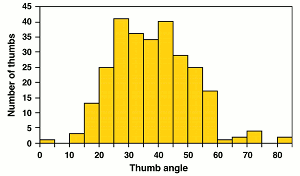The Hitchhiker’s Thumb is a thumb where the distal joint can bend as far backwards as 90 degrees. The Hitchhiker’s Thumb is often referenced as a visual trait of genetic inheritance.
Here we discuss the science behind it and how we developed a serverless webapp that allows people to score the angle of their thumb.
No large scale studies have been done to record the distribution of thumb angles worldwide so the Hitchhiker’s Thumb Angle Calculator may serve as a resource for this.
The science of the Hitchhiker’s Thumb
The Online Mendelian Inheritance in Man (OMIM) database references for distal hyperextensibility (Hitchhiker’s Thumb) the 1953 study (Pubmed). Here, Glass and Kistler define a Hitchhiker’s Thumb to be a thumb that bends more than 50 degree. In their study between 24.7% and 35.6% of individuals in the United States have a Hitchhiker’s Thumb.

A 1949 (294 individuals, USA) and 2012 (310 individuals, South-South Nigeria) identified a 5% and 32.3% angle respectively. Though the 1949 study was reported from X-ray.
Glass and Kistler concluded the Hitchhiker’s to be a simple Mendelian trait. That is people with the Hitchhiker’s thumb have two copies of the recessive “hitchhiker’s gene” (H offspring). As we inherit one gene from our parents each, that means both our parents have had this recessive gene themselves, however if they also had one copy of the dominant “straight thumb gene”, they may only be “carriers” rather than showing the trait.
Automatically detecting thumb angle
To facilitate discussions during events we ask participants to submit their thumb land live-track entries. The top three thumbs are shown on the screen alongside the number and distribution of submitted thumbs. However, you will not be able to admire the images for long as we are deleting the photo itself soon after submission and only retain the angle due to privacy reasons.
We put together a comprehensive article exploring the genomics behind the HitchhikersThumb and how we process the images. You can read the article on Medium.

Serverless web service
We chose a serverless operational model as we want the service to scale to potentially thousands of simultaneous users (during a presentation) while not having to pay anything if there is no activity on the page.
The user submits an image to the API gateway which triggers a lambda function to process the image and calculate the angle. This function deposits the resulting image on S3 and populates the dynamoDB table. It returns the angle, percentile, and s3 bucket url back to the user.
During presentations a webpage polls the dynamoDB table in realtime to find the top three most bent thumb as well as display the submission statistics (how many images uploaded and the distribution of the angles so far).

Take home message
Genomics hold the blueprint for our body, it therefore not only affects the way we look but also our future disease risk. Becoming more savvy in understanding the relationship between the genome and us will be important for health literacy going forward. The Hitchhiker’s Thumb Angle Calculator is a fun way to engage in this topic.


